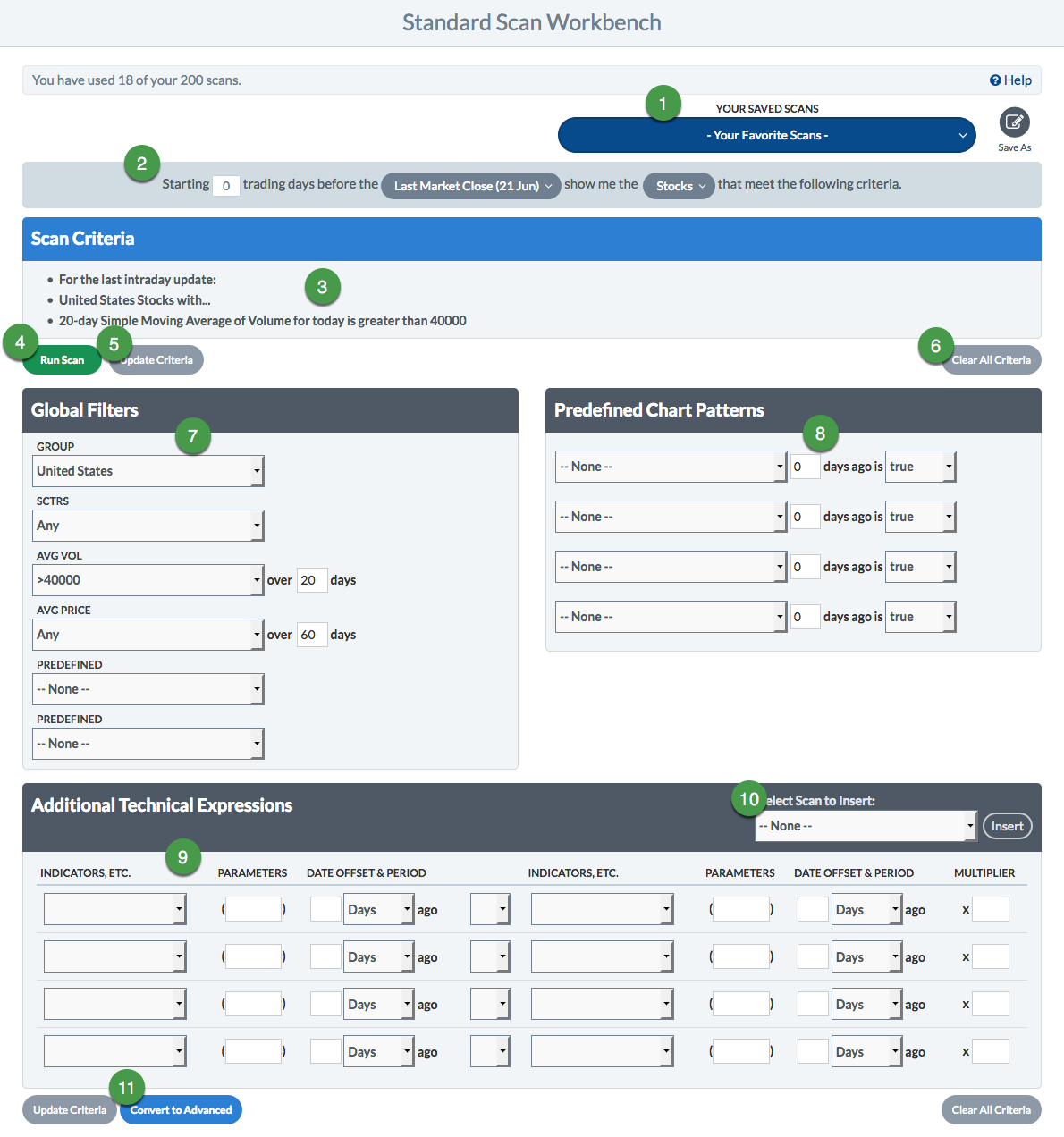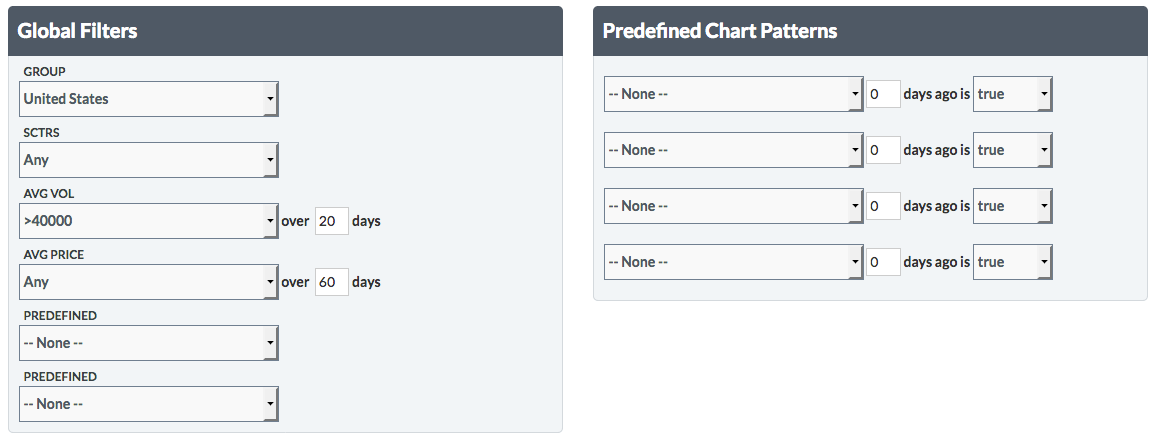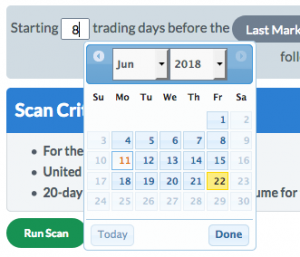This is an old revision of the document!
Table of Contents
Standard Scan Workbench
The Standard Scan Workbench offers Extra and Pro subscribers a quick way to find stocks, indexes, mutual funds or futures that fit specific technical requirements. This workbench allows you to construct simple scans from a number of pre-created options, with the ability to do minor modifications.
While the Standard workbench is faster at creating basic scans, we recommend that people use the Advanced Scan Workbench instead, as it provides more features and is extremely customizable. In addition, our Technical Alerts use the same “language” as the Advanced Scan Workbench, so learning one allows you to use both. The combination of the advanced scans and technical alerts is a very useful set of tools to have in your toolbox. The additional time spent learning them will be well worth the effort.
Please see our Advanced Scan Workbench article and our Technical Alerts article in the Support Center for more information about using these valuable resources.
Accessing the Workbench
To access the Standard Scan Workbench from Your Dashboard, click the “Standard Scan Workbench” link in the “Your Scans” section of the page.
Parts of the Workbench

- Scan Management
- Starting Date Adjuster
- Scan Criteria Box
- Run Scan Button
- Update Criteria Button
- Clear All Criteria Button
- Global Filters
- Predefined Chart Patterns
- Additional Technical Expressions
- Predefined Scan Insert Dropdown
- Convert to Advanced Scan Button
The use of each of these sections is described below.
Building a Scan
The Scan Criteria Box

The Scan Criteria Box (#3 in the picture above) contains the criteria used to run the scan. All scan clauses must be entered in this box in order to be part of your scan.
When you first create a new scan, there are two clauses already entered in the Scan Criteria Box. These are the default filters that are often used in scans; you are free to modify or remove these criteria from your scan. Additional scan clauses can be inserted using the Global Filters, Predefined Chart Patterns and Additional Technical Expressions sections.
If at any point you want to start over, clicking the “Clear All Criteria” button below the Scan Criteria Box will clear all scan criteria out of the box and reset it to the default criteria.
Global Filters and Predefined Chart Patterns

The Global Filters section can be used to limit the stocks returned by the scan, based on ticker properties, price and volume information and a number of technical events and patterns.
These clauses are broken down into several different categories, each having its own dropdown menu in the Global Filters section. Once you select a clause from one of the menus, click the “Update Criteria” button below the Scan Criteria Box; the clause will then be appended (with default settings) to the scan. For some of the filters, minor adjustments can be made to the default settings using other fields in the Global Filters section.
The Global Filter categories are listed below:
- Groups - Clauses that filter stocks by membership in various groups. This includes indexes (e.g. limiting to stocks that are in the S&P 500), countries, regions and exchanges, as well as your own ChartLists. Also includes ETF clauses that allow you to limit your results to non-inverse or leveraged ETFs.
- SCTRs - Clauses that limit your scan results to ticker symbols that meet certain SCTR ranking levels.
- Average Price and Volume - Clauses that allow you to limit your scan results to ticker symbols that meet certain price and volume levels over a set period of time. You can specify the set period of time using the boxes to the right of the Average Price and Volume dropdown menus.
- Predefined - Dropdown menus that allow you to define up to two technical conditions that ticker symbols must display in order to be included in the results. These conditions include events like MACD crossovers and 52-week highs/lows.
The dropdown menus in the Predefined Chart Patterns section allow you to define up to four chart patterns that ticker symbols must display in order to be included in the results. These patterns include Candlestick Patterns, Candlestick Building Blocks and P&F Patterns. For each pattern, you can define whether it should be displaying the pattern or not displaying it, as well as how many days prior to the scan date to test for the pattern.
In addition to these filters, you can limit to a certain type of security (stocks, mutual funds, indices, or futures) using the dropdown menu in the Starting Date Adjuster section. Note that some of the filters may not be applicable to mutual funds, indices or futures.
Additional Technical Expressions
The Additional Technical Expressions section can be used to check for up to four additional technical conditions that are not covered by the settings in the Global Filters and Predefined Chart Patterns sections. In this section, you build the clause piece by piece, rather than selecting the entire clause from a single dropdown menu.

In the Indicators dropdown on the left, you select an indicator for the left side of your clause. The Indicators dropdown includes both data fields (price and volume) as well as technical indicators (MACD, RSI, Stochastics, etc.).
If the indicator you added in the first column requires any parameters (e.g. the number of periods for the RSI indicator), those should be added in the Parameters field next to it.
The Date Offset & Period column allows you to specify the number of periods (days or weeks) into the past that the indicator should be moved. For example, you may want to compare the MACD value for 3 days ago. Remember that this value is using trading days, not calendar days.
The Comparison Operator is used to specify the type of comparison you wish to make between the two sides of the clause. Should they be equal to each other? Should the expression on the left be greater than the expression on the right?
Specify the expression for the right side of the scan clause, using the fields to the right of the comparison operator for Indicators, Parameters and Date Offset & Period.
On the far right, you can use the Multiplier field to scale the results of the indicator on the right side of the clause.
The following are some examples of technical expressions.
Search for stocks with a daily close today that is at least 50% greater than the daily close yesterday:

Search for stocks with a daily volume today that is over 3x greater than the 260-day simple moving average of volume AND for stocks with a daily close today that is more than 50% greater than its 30-day simple moving close average:

Search for stocks with a MACD line (12,26,9) that crossed above the MACD signal line (12,26,9) today AND for stocks with a daily volume today that is over 3 times greater than the 50-day simple moving average of volume:

Search for stocks with a closing price greater than 150:

Loading Predefined Scans to Customize
Using the “Select Scan To Insert” dropdown menu, you can choose a Predefined Scan to load into the Additional Technical Expressions section. The advantage of loading it here (instead of just choosing the scan from the Predefined dropdown in the Global Filters section) is that you can further customize the predefined scan once it is loaded in the Additional Technical Expressions section. It can also be a good learning opportunity, showing how to instruct the Scan Engine to do common scanning tasks by looking at the options that are set.
Converting to the Advanced Scan Workbench
One of the best learning opportunities available to Standard Scan Workbench users is the “Convert to Advanced” button at the bottom of the page. Once you have created a scan in the Standard Scan Workbench, you can click this button to convert your scan to Advanced Scan Syntax and display it in the Advanced Scan Workbench. If you are not sure of the syntax to use for a specific scan, this can be a great way to discover it.
Note that this process only works in one direction, Standard to Advanced. It is not possible to automatically convert an Advanced scan into a Standard one.
Scans saved in a particular workbench can only be edited in that workbench. Thus, if you try to open an Advanced Scan in the Standard Scan Workbench, you will be automatically redirected to the Advanced Scan Workbench.
Managing Your Scans

Once you've built your scan, saving the scan criteria allows you to reuse your custom scans any time you want, without having to re-enter all the filters. Extra users can save up to 200 custom scans on their account, while Pro members can save up to 300.
The Scan Management area of the Standard Scan Workbench allows you to add, view, modify and delete your saved scans.
When you first create a new scan, you can save it by clicking the “Save As” button in the Scan Management area. You will be prompted to enter a name for your scan. Choose a name that will help you find it again later. Your scans will be listed alphabetically by name, so you may want to add a prefix to each scan name in order to group your scans by the main indicator used or, alternately, by bullish vs. bearish scans. (Use whatever form of organization is most useful to you.)
To load a saved scan in the Standard Scan Workbench later, click the “Your Saved Scans” dropdown menu in the Scan Management area and find your scan on the list. They are arranged alphabetically by scan name. You can tell which saved scan is loaded in the Scan Criteria Box, as the name of the currently-loaded scan will be displayed in this dropdown box.
If you make changes to your saved scan, you can save the changes by clicking the “Save” button in the Scan Management area. If you want to save a copy of the scan, you can click the “Save As” button and specify a different name for the new copy of the scan.
In the event that you no longer need a scan, you can delete it by loading it in the Scan Criteria Box and clicking the “Delete” button in the Scan Management area.
Using Your Scan
Once your scan has been built, running it will be fairly simple. However, there is one step you might want to take before pressing the “Run Scan” button.
The Starting Date Adjuster

Before running your scan, you can use the Starting Date Adjuster to specify which day of data the scan is run against. This can be used to “backtest” a scan - that is, to see what results it would have returned at some point in the past.
The default setting is 0 days before the Last Intraday Update (during market hours) or Last Market Close (outside of market hours). Most of the time, you'll want to find stocks that meet the criteria right now, so the default settings will be just fine.
If you need to change the settings, you can specify that your scan start up to 3000 trading days (roughly 12 years) in the past. Keep in mind that, depending on your scan criteria, the further back you go, the less accurate your results will be. Specifically, exponential moving average calculations require a larger number of data points to be accurate. EMAs with large offsets are prone to inaccuracies.
When you click in the “Starting” box, a popup calendar will display the associated date for that offset value. Alternately, if you click on a date in the calendar, that offset will be put into the “Starting” box.

The offset will be relative to either the latest intraday update or the last close, based on the selection in the dropdown menu.
Note: The Scan Engine will only run the scan on one date at a time. That is to say, the Scan Engine cannot run a single scan over a date range. For example, you may wish to run a scan for 52-week highs on the dates within the range of October 4-7; currently, however, this requires four separate scans using the appropriate date offsets.
Running the Scan
To run the scan, simply click the “Run Scan” button below the Scan Criteria Box. The scan results will subsequently launch in a new tab or window for you to view.
Be sure to check out the Working with Scan Results page for more information on getting the most out of your scan results.
Conclusions
While the Standard Scan Workbench is no longer recommended for everyday scanning use, it can still be used as an educational tool to help you get up to speed on using our scanning syntax and the Advanced Scan Workbench.
Next Up » Working with Scan Results